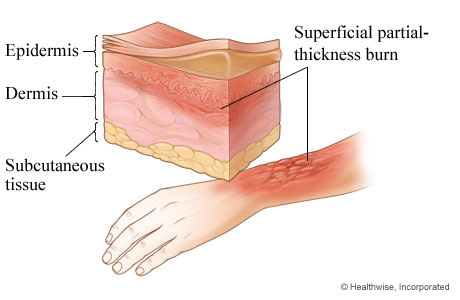Second-degree burn: Superficial partial-thickness burn

A superficial second-degree burn injures the top layer of skin (epidermis) and may injure a small area of the tissue (dermis) below the skin.
How to care for a second-degree burn
For many second-degree burns, home treatment is all that is needed for healing and to prevent other problems.
- Rinse the burn.
- Rinse burned skin with cool water until the pain stops. Rinsing will usually stop the pain in 15 to 30 minutes. The cool water lowers the skin temperature and stops the burn from becoming more serious. You may:
- Place arms, hands, fingers, legs, feet, or toes in a basin of cool water.
- Apply cool compresses to burns on the face or body.
- Do not use ice or ice water, which can cause tissue damage.
- Take off any jewelry, rings, or clothing that could be in the way or that would become too tight if the skin swells.
- Rinse burned skin with cool water until the pain stops. Rinsing will usually stop the pain in 15 to 30 minutes. The cool water lowers the skin temperature and stops the burn from becoming more serious. You may:
- Clean the burn.
- Wash your hands before cleaning a burn. Do not touch the burn with your hands or anything dirty, because open blisters can easily be infected.
- Do not break the blisters.
- Gently wash the burn area every day with a mild soap and water. Some of the burned skin might come off with washing. Pat the area dry with a clean cloth or gauze.
- Do not put pain-relief skin sprays on burns, because this traps the heat inside the burn.
- Apply ointment to keep the burn moist.
- You may want to use petroleum jelly or an antibiotic cream or ointment, like bacitracin or triple antibiotic ointment. Apply the antibiotic cream or ointment to a nonstick dressing, and then place the dressing (ointment-side down) on the burn.
- Using antibiotic cream or ointment for longer than a week may cause a rash. So if you're using a topical antibiotic, you may want to switch to petroleum jelly or another type of ointment or cream after a week.
- Or you may want to use a product where the gauze dressing pad comes already coated with petroleum jelly or a similar ointment to keep the burn moist as it heals.
- Bandage the burn.
- Use gauze or tape to keep the dressing in place.
- Wrap the burn loosely to avoid putting pressure on the burned skin.
- Do not tape a bandage so that it circles a hand, arm, or leg. This can cause swelling.
- Apply a clean bandage whenever it gets wet or soiled. This can help prevent infection. If a bandage is stuck to a burn, soak it in warm water to make the bandage easier to remove.
Until the burn heals, wash the burn every day with a mild soap and water, unless your doctor says otherwise. (Some dressings shouldn't be changed every day.)
There are many nonprescription burn dressings available. Be sure to follow the instructions included in the package.
Take an over-the-counter pain medicine, such as acetaminophen (Tylenol), ibuprofen (Advil, Motrin), or naproxen (Aleve), as needed. Read and follow all instructions on the label. Do not use aspirin, because it can make bleeding in the burned area worse.
If the burn is on a leg or an arm, keep the limb raised as much as possible for the first 24 to 48 hours to decrease swelling. Move a burned leg or arm normally to keep the burned skin from healing too tightly, which can limit movement.
©2011-2025 Healthwise, Incorporated
